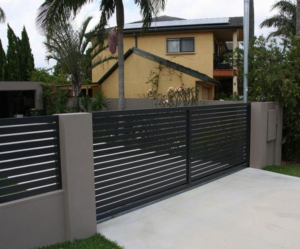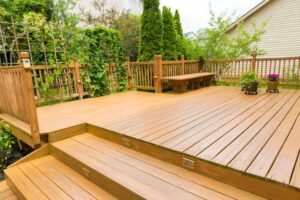R.C Fence LLC is one of the most popular home improvement projects. It adds privacy to your yard and allows you to garden, play catch, or sunbathe without worry.
Before installing a partition fence, speak with your neighbors first. While no laws require this, it’s good etiquette and shows that you care about your neighbors.

Wood fences are traditional and can be found in a wide variety of styles and sizes. Some types of wood are more durable than others, but all require regular maintenance. Staining and painting are needed to keep the natural beauty of wood intact. Wood can also be prone to moisture, which can damage the structure and reduce its lifespan.
A good option is cedar, which naturally resists rot and insects. Cedar can be left to weather naturally, but it’s best to seal the wood on a regular basis for longevity. Cedar is a little more expensive than spruce and pine, but it’s a beautiful material that will provide a classic look.
When choosing a wood fence, ask the installer to use sustainable lumber that has been certified as coming from a legal source. This will help minimize your impact on the environment.
Another option is composite, which combines the strength of wood with the durability of plastic polymers. This type of fence is also popular with homeowners who are looking for a low-maintenance solution that looks great. The main drawback of this type of fence is that it’s not as sturdy as wood and can be prone to warping and other problems.
Before you build a residential fence, make sure to get a property survey. This will determine the actual property line, which is critical to prevent boundary by acquiescence (where you may lose some of your own land to your neighbor’s fence). You should also consult with a local landscaping professional who can advise you on what trees and bushes would grow well in your area and give you the privacy you crave.
Vinyl, also known as PVC, is a highly versatile fence material that offers homeowners a range of aesthetic preferences and practical benefits. This material holds up incredibly well in cold climates and will resist long-term exposure to ultraviolet (UV) rays. This helps to protect your home’s exterior and keep it looking brand-new. This durable material is used for a variety of residential products, including windows and siding. Its durability also translates to fencing, which is why vinyl is growing in popularity among homeowners.
In addition to its longevity and aesthetic appeal, vinyl is a great alternative to wood fences because it does not rot or rust. It is also easy to clean. A simple hose down is all that is needed to remove dirt and debris from the surface. However, it is important to note that a vinyl fence can still be damaged if a severe impact occurs.
Another reason to consider a vinyl fence is its high level of security. Since it is difficult to climb or cut, this type of fencing offers a strong deterrent against intruders. This is especially useful for families with children or pets who may wander onto the property without supervision.
One drawback of a vinyl fence is its upfront cost, which can be higher than some other fencing materials. However, this type of fence offers substantial savings in terms of maintenance and repair costs. It is also an environmentally friendly choice because it is made from a recycled material.
From zigzag post-and-rail styles to elaborate molded vinyl styles, fences are the home-owner’s choice for separating properties, defining space and keeping pets and children safe. They also serve as a backdrop for landscaping and yard art. Whether you prefer the understated lines of this tubular aluminum fence or the classic wrought iron hoop-and-spear design shown, the material is easy to paint and add decorative details for an attractive home feature.
Resistant to rust, corrosion and dents, and more affordable than metal options like iron and steel, aluminum fences don’t require staining or painting. They’re also lighter than their steel counterparts, making them easier to install and move around for maintenance.
Prefabricated aluminum panels are available at most home centers and DIY-friendly home and garden stores, starting at about $10 per linear foot, uninstalled. Home centers stock a limited selection of designs, though, while professional fence installers can order 6-foot-long tubular-aluminum panels in a wide range of designs to match your home or property. A pro can also “rack” these aluminum fence panels, stepping them down along a sloped property to follow the grade consistently.
Aluminum is an abundant, nonferrous metal with a silvery-white color and natural luster. It’s a good conductor of electricity and found in window frames, door frames, sidings, roofing, gutters, railings, cans, foils, cooking utensils, automobile parts, bicycle wheels, and even telescope mirrors [1]. The metal also serves as an alloy with copper to make softer, stronger metals, such as wrought iron or cast iron, for structural applications. Iron and aluminum are both highly recyclable materials. This makes them a green option for homeowners who want to protect the environment. It’s also cost-effective for them to do so because they can reclaim and recycle these fence parts over their lifespans.
Residential steel fencing adds a beautiful, polished aesthetic to the home and property. It is also the most durable and secure option for protecting a home from intruders and can even deter a vehicle. This type of fencing typically comes in two forms: galvanized and stainless steel. Steel fence posts will not rust when exposed to the elements, unlike wood posts, which will eventually rot and break down with time. Steel fences can be very expensive, but their longevity is worth the investment.
When considering a new residential fence, be sure to consider the size and layout of your yard and whether there are any other structures or landscaping features that may impact the placement of your fence. In addition, be sure to check with your town and homeowner’s association for guidelines on style and placement. Some municipalities require a permit, and it is possible that drilling holes for your fence posts could hit buried utility lines.
Choosing the right fence material for your property is an important decision and one that shouldn’t be taken lightly. If you have questions about the different fencing options available, be sure to contact our experienced team of professionals. We would be happy to discuss your options and help you find the perfect fence for your home!
Ornamental steel fences are a beautiful and attractive way to enhance your property, but they can be difficult to maintain. In order to keep them looking their best, it’s a good idea to rinse off dirt as needed and periodically check for signs of rust. A skilled fence contractor will be able to provide the maintenance your ornamental steel fence needs to look its best.
Vegetation is the living plant matter in a region or ecosystem, typically as ground cover. It is the principal element of the biosphere and can be at any stage of development, from tiny bacteria or moss to towering redwood trees. It is different from flora, which refers exclusively to species composition.
Generally, vegetation classifications are made on a large scale and focus on general categories such as grassland, forest, or shrubland. The categories may be further divided into habitat types such as savanna, desert, chaparral, and marsh. Depending on the purpose of the classification, some classification systems may also include a description of floristic assemblages or units recognizable from aerial photographs.
Some people use the term “vegetation” to refer to the plants that grow around their homes or yards, such as bushes and trees. In this case, the plants are not used as a fence but rather to add beauty and seclusion to a property. While this approach is less expensive than installing a traditional fence, it can take some time to achieve the desired results. If you decide to use vegetation as your residential fence, consult a local landscaping professional to ensure that the plants will thrive in your climate and soil conditions.
Some people may choose to use vegetated facilities on their properties to slow down, filter, and absorb stormwater runoff after it rains. These types of facilities are commonly known as bioretention and bioswales. They are a form of green infrastructure and are included in best practices for erosion control. These structures are often constructed from a combination of materials, including natural wood and gravel or soil. They are also often designed to be decorative and are more attractive than conventional retaining walls.

